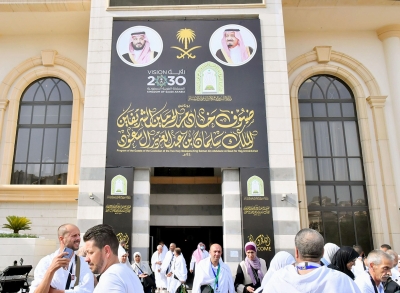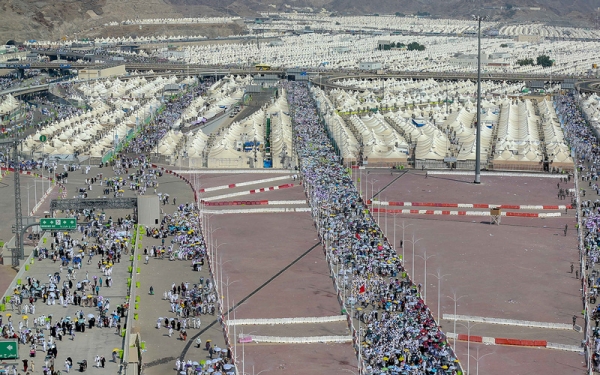
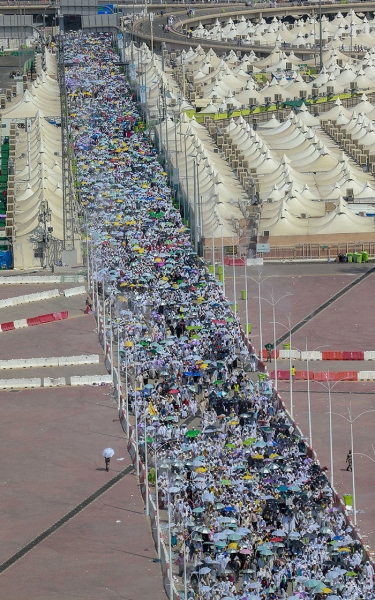
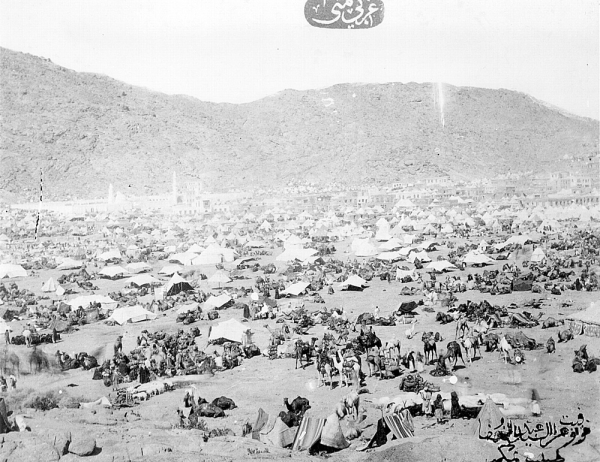
The Holy Site of Mina is the first of the Holy Sites that pilgrims visit in Makkah al-Mukarramah. In Mina, pilgrims spend the eighth day of the month of Dhul-Hijjah, as well as the last Tashreeq days of the Hajj. It contains the three Jamarat (pillars): al-jamrah al-sughra (the smallest jamrah), al-jamrah al-wusta (the middle jamrah), and Jamrat al-Aqabah (the largest jamrah). Al-Khayf Mosque is also located in it, and it is the closest Holy Site to the Grand Mosque. Furthermore, it is considered the largest tent city in the world.
Geography of the Holy Site of Mina
Geographically, the Holy Site of Mina is situated in a valley surrounded by mountains on its northern and southern sides, with Jamrat al-Aqabah towards the side of Makkah al-Mukarramah, and Muhassir Valley towards Muzdalifah. It remains uninhabited except during the Hajj season, and it has several buildings dedicated to governmental and service agencies.
Area of the Holy Site of Mina
The area of the Holy Site of Mina, within its Shariah boundaries, is approximately 16.8 km². Pilgrims stay there throughout the Hajj days, except for the ninth of Dhul-Hijjah, which they spend at Arafat site, and they spend the night that follows at Muzdalifah site.
The Naming of the Holy Site of Mina
There are several narratives regarding the naming of the Holy Site of Mina. One of them is that Adam longed for Paradise there, and it is a place where people gather; because in Arabic, locations where people congregate are often referred to as Mina. The site is located seven km away from the Grand Mosque.
Historical events at the Holy Site of Mina
The Holy Site of Mina is linked to historical events, including when the Prophet Ibrahim, peace be upon him (PBUH), stoned the three Jamarat and sacrificed a ransom for his son Ismail (PBUH). Additionally, the Prophet Muhammad (PBUH) performed these rituals during the Farewell Pilgrimage. Surah al-Nasr was revealed during the Farewell Pilgrimage of the Prophet Muhammad (PBUH). It was in Mina that the two Ansar Pledges, known as the First and Second Pledges of Aqaba, took place. Within its borders stands the Aqaba Mosque, built by Abbasid Caliph Abu Jaafar al-Mansur in 761.
Yawm al-Tarwiyah at the Holy Site of Mina
Pilgrims spend Yawm al-Tarwiyah (The Day of Quenching Thirst) in the Holy Site of Mina, which is the eighth day of Dhul-Hijjah. Pilgrims there pray the Dhuhr, Asr, Maghrib, and Isha prayers individually, without combining them. It is Sunnah to spend the night in Mina, following the tradition of the Prophet Muhammad (PBUH). The pilgrims return to Mina on the morning of the tenth day of Dhul-Hijjah after stopping at Arafat on the ninth day of Dhul-Hijjah, then overnighting in Muzdalifah.
Pilgrims who are not in a hurry spend the three days of Tashreeq in the Holy Site of Mina throwing the three Jamarat, starting with al-Jamrah al-Sughra (the smallest Jamrah), then al-Jamrah al-Wusta (the middle Jamrah), and finally al-Jamrah al-Kubra (the largest Jamrah). Those with time constraints spend two of the three days of Tashreeq there.
The term "Tashreeq" finds its linguistic roots in the word for "Sharq" (east). It earned this name because, as Ibn Hajar described, Arabs traditionally practiced Tashreeq of the meat of sacrificial animals to the sun, a process involving cutting, tenderizing, and distributing the meat.
Landmarks of the Holy Site of Mina
The Holy Site of Mina has a number of landmarks, including:
Wadi Muhassir
Abraha the Abyssinian's elephant ceased its movement and proceeded towards Makkah al-Mukarramah, emulating the example of the Prophet Muhammad (PBUH) during his passage through the valley in the Farewell Pilgrimage of the tenth year of the Hijra. The valley spans two km in length and twenty m in width.
Al-Khayf Mosque
It is one of the Holy Site of Mina’s landmarks. Its structure was expanded in 1987. Its area is 23,500 m and can accommodate about 25,000 worshippers. The mosque has four minarets and is equipped with all the necessities, including lighting, air conditioning, and furnishings, as well as 1,700 restrooms for men and women.
The Ministry of Islamic Affairs, Dawah, and Guidance uses the mosque as a headquarters for activities and religious programs offered to the pilgrims, with the aim of educating them about the rituals and regulations of the Hajj.
Jamarat Complex
It was specifically for walking Hajj pilgrims to perform the Stoning of the Devil during the days of Hajj. It includes: al-Jamarah al-Wusta, al-Jamarah al-Sughra, and al-Jamarah al-Kubra, also called al-Aqaba.
The facility comprises five floors, each measuring twelve m in height, with a current capacity of accommodating three hundred thousand pilgrims per hour. The project's foundations were designed to support twelve floors and accommodate five million pilgrims in the future. Its cost exceeded SAR4.2 billion, and it is the first holy site facility following Makkah al-Mukarramah.
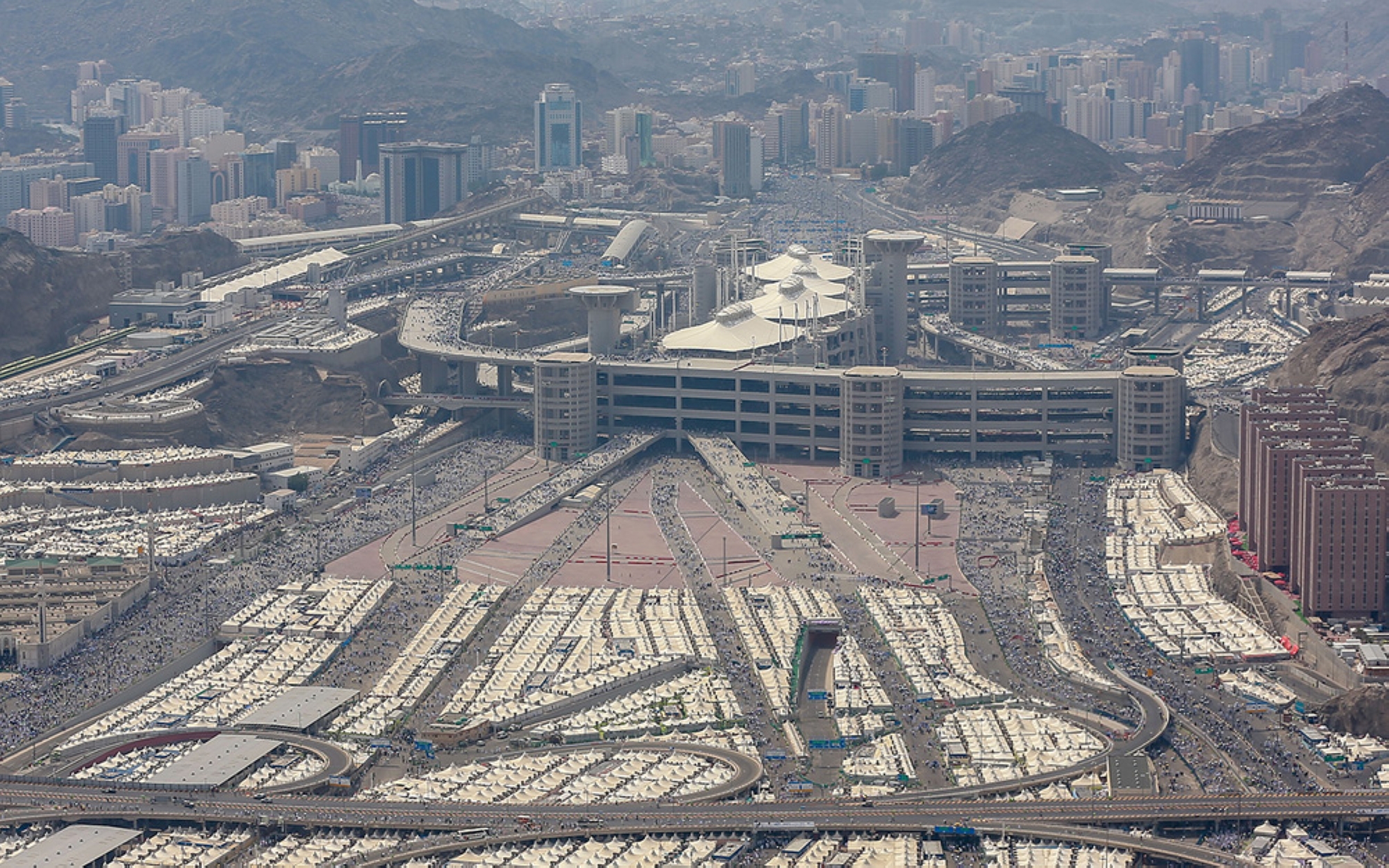
The tents project in the Holy Site of Mina
The developed tent project in the Holy Site of Mina was implemented on an area estimated at approximately 2.5 million m, with specifications aimed at ensuring greater security and safety for pilgrims, accommodating around 2.6 million pilgrims.
Glass fabrics covered with Teflon were utilized in the manufacture of the tents due to their high resistance to flames and their non-emission of toxic gases, except at high temperatures.
The tents occupy 20 percent of the total area of the Holy Site of Mina. Additionally, there are thirty thousand fire-fighting sprinklers, three thousand surveillance cameras, 12,000 guidance and warning systems, 15,000 air conditioning and ventilation units, as well as restrooms.
Related quizzes

